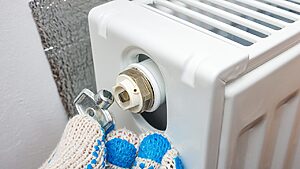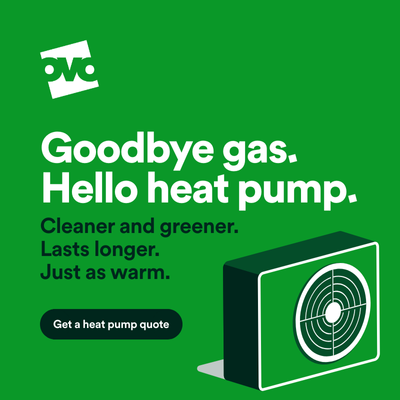Why Air Release Valves and Deaerators are Non-Negotiable
For as long as we have had closed-loop heating systems, air has been their enemy. It slips in during installation, it finds its way in through microscopic leaks, it emerges from solution whenever temperatures and pressures fluctuate. Left unmanaged, it corrodes, blocks, howls and undermines the very purpose of a heating system. This is why, traditionally, every system has included an air release valve.
Recently, during pipework alterations on our buffer tank and central heating system, our installer removed ours. We asked him to reinstate it. He refused, insisting we did not need one. Against our better judgement, we let it slide.
The consequences were immediate and, frankly, disastrous. The system had been drained, flushed and refilled, and we strongly suspect that the underfloor heating circuits had also been emptied. A new pump was installed. Once everything was re-pressurised and switched on, the system was awash with air. The sound was intolerable.
Each time the pump started, the noise of bubbles and air being whipped through the pipework was enough to stop conversation. It sounded like an industrial kettle boiling itself inside-out. Watch the short video below.
For days this continued. The installer said this was normal and that we should just keep bleeding radiators repeatedly, and only on the very first attempt did any significant air escape. Every effort thereafter produced nothing, yet the system is filled with air. The installer had no solutions. He fiddled with unions, sprayed water around the utility cupboard in the process, and then shrugged. His advice was to keep bleeding radiators for a few weeks and wait for the problem to resolve itself. It did not.
This is the crux of the matter: in any heating system, but especially in modern low-temperature heat pump systems, air is not an inconvenience, it is a systemic threat. It reduces efficiency because circulation is impeded. It reduces heat transfer because radiators and underfloor loops cannot emit what they are meant to emit when pockets of gas stand in the way. It accelerates corrosion because oxygen is now present in the very medium that is supposed to be protecting the steel and copper of your system. Most dangerously, it damages pumps through cavitation.
Cavitation is not a word most homeowners know, but it ought to worry them. When a pump operates in the presence of air and fluctuating pressure, gases come out of solution, forming vapour bubbles. When these collapse, they do so violently enough to pit and scar metal. Over time, cavitation will destroy a pump, and with it the very heart of the system. This is not abstract theory: it is visible, measurable damage and once it starts it cannot be undone.
What makes this particularly unforgivable is that the solution is neither exotic nor expensive. Automatic air vents have long been the standard defence, positioned at high points to allow accumulated air to escape quietly and continuously. They are small, cheap (around £10) and their absence is noticeable only when it becomes a problem.
Deaerators, meanwhile, represent the next level of protection. Devices such as the IMI Zeparo ZTVI do not merely deal with the large bubbles that eventually collect in predictable places. They strip out micro-bubbles, the dissolved gases that appear under low pressure and high velocity, which cause the fizzing and hammering that homeowners hear and that engineers know will one day destroy a pump. A good deaerator functions regardless of orientation, can be rotated to suit cramped plant rooms and will operate for the lifetime of the system.
This is where the argument so often collapses into frustration. Why do some installers continue to resist? The excuses vary. Some genuinely believe that bleeding radiators periodically is sufficient, as though we were still in the era of cast iron boilers thundering away at 80C and masking inefficiencies with brute force. Others are cutting costs, shaving off every component that is not absolutely necessary to get the system running on the day of commissioning. Some simply do not understand the hydronic dynamics of low-temperature systems, where small disruptions have disproportionate consequences. And some, frankly, are arrogant: convinced that they know better than manufacturers, better than decades of practice, better than physics itself.
But there is no way around it: low-temperature heating systems are especially vulnerable. The very qualities that make them efficient (constant circulation, low flow temperatures, finely balanced emitter sizing) also make them intolerant of error. Air that might have been masked in an old boiler system will wreak havoc in a heat pump circuit. Radiators and underfloor loops designed for low delta-T cannot afford to lose surface area to air pockets. Pumps that are already working near the lower end of their headroom cannot endure the added burden of cavitation. Efficiency gains of a few percentage points, which matter enormously to the homeowner’s bills and carbon footprint, are simply sacrificed.
This is why it is impossible to accept the suggestion that air release valves or deaerators are optional. They are not in my opinion. And when installers tell homeowners that they do not need them, they are not only wrong, they are negligent. The cost of retrofitting is always higher, the damage already underway by the time the oversight is corrected. Worse still, the homeowner has often lost confidence in the system entirely, and in the technology that powers it.
In our case, the lesson was hard learnt. We currently live with a system that growls and fizzes, that never truly clears, that reminds us daily of one moment when we failed to insist. It is not fine. It will not fix itself. And it should never have been allowed to happen. So now we've had to hire another installer to add an air release valve, which is another disruption and another labour cost.
Demand an air release valve at the very least. Better still, insist on a deaerator. Do not let your installer dismiss the need for one, or wave you away with talk of bleeding radiators. Do not allow them to take something so fundamental and treat it as an optional extra, because the day will come when your system has to be drained and refilled, and without proper air removal you will be right back in the same mess. Air in a heating system is not a minor inconvenience; it is a slow-motion disaster. And it is entirely preventable.
(adsbygoogle = window.adsbygoogle || []).push({});
Get a copy of The Ultimate Guide to Heat Pumps
Subscribe and follow our YouTube channel!
On the back of this, I'm curious to hear who has an air release valve or deaerator, and who doesn't have any air release mechanism.
Get a copy of The Ultimate Guide to Heat Pumps
Subscribe and follow our YouTube channel!
We have air release valves - the automatic ones with the little screw caps. One is installed as part of our Joule pre-plumbed cylinder, at the high point above the motorised valves. The installers also installed another one in the top of the volumiser which seems a great place for air to separate out and rise.
Back in the old days, before automatic air vent valves, we just had a virtual copper pipe sticking up in the airing cupboard with a threaded cap at the top one could loosen to let the air out. You could feel from the heat of the pipe if much air had built up since last released.
I agree, for the sake of £10 I'd scatter a few around the system at any high points.
Samsung 12kW gen6 ASHP with 50L volumiser and all new large radiators. 7.2kWp solar (south facing), Tesla PW3 (13.5kW)
Solar generation completely offsets ASHP usage annually. We no longer burn ~1600L of kerosene annually.
Posted by: @editorOn the back of this, I'm curious to hear who has an air release valve or deaerator, and who doesn't have any air release mechanism.
I have one installed when my heat pump was done, connected to the cylinder feed (or it may be the cylinder return). The cylinder is on the first floor of my two storey house so this is pretty much the high point. The installer did this without being asked, so its obviously standard procedure for him.
The heat pump has a 'purge building circuit' function which the installer ran for 10-20mins when he had finished the plumbing, to release most of the trapped air. I think that this function just runs the water pump at maximum but Im not absolutely sure, it may play games also with the diverter valve to ensure that the whole system is swept.
Nevertheless there was one tall radiator which needed manual bleeding every day for about a month as dissolved air, which could not have been purged by the installer, came out of solution. Im guessing most of the dissolved air ended up being vented by the air release valve, but the local 'high' represented by the radiator remained a trap for small bubbles which the flow through the radiator didn't sweep away.
There was a de-aerator on a public splash pool I was once responsible for, which certainly worked, but not on my heating system.
4kW peak of solar PV since 2011; EV and a 1930s house which has been partially renovated to improve its efficiency. 7kW Vaillant heat pump.
We have a manual air release valve on top of the Grant Low Loss Header/volumiser. This is a good location as the velocity through the system is lowest at this point in the circuit, allowing air bubbles to separate out rather than be entrained and carried round the system.
I'm wary of automatic air vents on pressurised sealed systems, as over time their operation slowly reduces the system pressure. If the heat emitter has a pressure sensor and minimum static pressure requirement, that can then cause a fault.
A manual vent next to the filling loop and system pressure gauge is ideal, fitted to a part of the circuit where air can accumulate to be released. That way, the system pressure can be topped up after manual venting. Automatic air vents should only be used with open heating circuit systems in my view.
Posted by: @allyfishWe have a manual air release valve on top of the Grant Low Loss Header/volumiser. This is a good location as the velocity through the system is lowest at this point in the circuit, allowing air bubbles to separate out rather than be entrained and carried round the system.
I'm wary of automatic air vents on pressurised sealed systems, as over time their operation slowly reduces the system pressure. If the heat emitter has a pressure sensor and minimum static pressure requirement, that can then cause a fault.
A manual vent next to the filling loop and system pressure gauge is ideal, fitted to a part of the circuit where air can accumulate to be released. That way, the system pressure can be topped up after manual venting. Automatic air vents should only be used with open heating circuit systems in my view.
When I had my system serviced recently, I asked the guy about the automatic air vents as I didn't really understand how they worked.
He advised once the system has been bled, to keep them closed by tightening the little screw cap and to manually open occasionally to manually bleed air from the system. He said the automatic valves can sometimes fail and then obviously you'll get a leak from the pressurised system if they are left open, so I just manually open mine occasionally now to check for air.
I remember talking to the installer when they were filling the system and them explaining that the automatic air vent on the top of the volumiser would just let all the air out (~50L worth) as the volumiser slowly filled with water from the bottom and then automatically seal once full. I think this automatic air vent may still be 'open'.
Does anyone know, if there is trapped air, do you hear a hissing sound as it's released with these automatic air vents, like the old fashioned ones or when bleeding a radiator, or are they silent?
Samsung 12kW gen6 ASHP with 50L volumiser and all new large radiators. 7.2kWp solar (south facing), Tesla PW3 (13.5kW)
Solar generation completely offsets ASHP usage annually. We no longer burn ~1600L of kerosene annually.
@old_scientist I had an automatic float type air vent on my old open heating system at the top of the circuit. It only had a small static head of about 0.5m of water (the height to the header tank above it) at the air vent location. I installed them at the top of a vertical riser pipe, so that they would be out of the flow stream and so air could settle out. Mine worked ok, but they can start to weep as they get older, once they have passed air and fluid a few times dirt, limescale and residue can accumulate and compromise the valve seal. I would always fit a 1/4 turn isolation valve before them so they can easily be changed out without having to partly drain down.
My view remains that, for pressurised heating systems, anything that permits pressure to escape automatically is not a good idea. I'm welcome to suggestions from this forum that my view is incorrect and being challenged on that one. We're all learning!
PS: If you're going to use an automatic air vent manually, and close it off, you might as well fit .... you guessed it .... a manual air vent! 😉
Posted by: @allyfishMy view remains that, for pressurised heating systems, anything that permits pressure to escape automatically is not a good idea. I'm welcome to suggestions from this forum that my view is incorrect and being challenged on that one. We're all learning!
PS: If you're going to use an automatic air vent manually, and close it off, you might as well fit .... you guessed it .... a manual air vent!
I confess to the same misgivings! My installer fitted one so I have one, but would I fit one again, possibly not, or if I do as you say fit an isolation valve immediately prior!
4kW peak of solar PV since 2011; EV and a 1930s house which has been partially renovated to improve its efficiency. 7kW Vaillant heat pump.
Posted by: @allyfish@old_scientist I had an automatic float type air vent on my old open heating system at the top of the circuit. It only had a small static head of about 0.5m of water (the height to the header tank above it) at the air vent location. I installed them at the top of a vertical riser pipe, so that they would be out of the flow stream and so air could settle out. Mine worked ok, but they can start to weep as they get older, once they have passed air and fluid a few times dirt, limescale and residue can accumulate and compromise the valve seal. I would always fit a 1/4 turn isolation valve before them so they can easily be changed out without having to partly drain down.
My view remains that, for pressurised heating systems, anything that permits pressure to escape automatically is not a good idea. I'm welcome to suggestions from this forum that my view is incorrect and being challenged on that one. We're all learning!
PS: If you're going to use an automatic air vent manually, and close it off, you might as well fit .... you guessed it .... a manual air vent! 😉
Top tip to fit an isolation valve!
All good points. I guess that at least with an automatic air vent valve you have the option to operate it automatically or manually, should you so wish. For most people, who may not even know what it is, it should just work and help keep air in the system to a minimum, and for those like me that worry they may start to leak over time, I can close them off and not worry. So from an installer's perspective, they are a no-brainer (other than the £10 of additional cost). I'm perplexed why @editor's were removed.
Samsung 12kW gen6 ASHP with 50L volumiser and all new large radiators. 7.2kWp solar (south facing), Tesla PW3 (13.5kW)
Solar generation completely offsets ASHP usage annually. We no longer burn ~1600L of kerosene annually.
FWIW, nearly a year after my heat pump install, I bled a radiator today and probably a third of it was filled with air. I do have an autovent fitted at a sensible place, but they cant guarantee that air wont collect elsewhere if there are other local 'high' points. The rad in question is a towel rail and extends about 1.5m above the floor. My wife alerted me to the fact it needed bleeding.
So even if you do fit autovents you are not immune to air collecting in the system.
4kW peak of solar PV since 2011; EV and a 1930s house which has been partially renovated to improve its efficiency. 7kW Vaillant heat pump.
@chas-b and @pirate-rich spent the day with us today tackling the air in the system. There was an obscene amount left behind after the recent bodged fix, but they were absolute troopers. After a marathon session, the system is finally air-free. They also fitted a fill-and-flush (fantastic bit of kit that I’ll share more about later this week) along with an air release valve.
Get a copy of The Ultimate Guide to Heat Pumps
Subscribe and follow our YouTube channel!
Posted by: @editor@chas-b and @pirate-rich spent the day with us today tackling the air in the system. There was an obscene amount left behind after the recent bodged fix, but they were absolute troopers. After a marathon session, the system is finally air-free. They also fitted a fill-and-flush (fantastic bit of kit that I’ll share more about later this week) along with an air release valve.
Are you saying that Brendon delivered a bodge up? Is that the "recent bodged fix" you refer to, or am I misreading this?
Retrofitted 11.2kw Mitsubishi Ecodan to new radiators commissioned November 2021.
14 x 500w Monocrystalline solar panels.
2 ESS Smile G3 10.1 batteries.
ESS Smile G3 5kw inverter.
- 26 Forums
- 2,357 Topics
- 53.5 K Posts
- 190 Online
- 6,025 Members
Join Us!
Worth Watching
Latest Posts
-

RE: Setback savings - fact or fiction?
I could, but I think we can do better, by plotting hour...
By cathodeRay , 7 hours ago
-
RE: Midea ASHP – how to set weather compensation
Just one more thought. If you have convenient space fo...
By JamesPa , 9 hours ago
-
RE: Advice on internal circulation pump noise
Extend the primary branch and make sure you have more t...
By ASHP-BOBBA , 10 hours ago
-

RE: External pipework insulation
Oh Dear! that's appalling pipe work, should've been in ...
By dgclimatecontrol , 15 hours ago
-

RE: Jokes and fun posts about heat pumps and renewables
By Morgan , 15 hours ago
-

RE: Controlling Daikin Altherma via P1P2 and Home Assistant
On the contrary, @toodles, that’s a lot of help. I’d ne...
By Majordennisbloodnok , 17 hours ago
-
RE: Octopus Cosy Heat Pump Owners & Discussion Thread
@kevh with the Cosy 6 I know it definitely goes to arou...
By HarrisonC , 1 day ago
-

Parsnip, Bacon & Coconut Milk Soup
First let me say, I am only a cook because I am human a...
By Toodles , 1 day ago
-
RE: Electricity price predictions
Ben Watts posted on LinkedIn that he had updated this w...
By Judith , 2 days ago
-

RE: The good, the bad and the not that great – my heat pump installation
Small update, Emailed and Spoke to Midea UK and they ...
By Burtis , 2 days ago
-
RE: Solis S6-EH1P8K-L-PLUS – Why I Chose It and What I’ve Learned So Far
@bash Octopus does charge for the admin. The process al...
By Batpred , 2 days ago
-
RE: New Fogstar 15.5kWh upright solution
Issues still under investigation by Solis... Fogstar ...
By Batpred , 2 days ago
-
RE: Who's your electricity provider and what's your tariff?
I agree, the consumer is not being properly represented...
By Batpred , 2 days ago
-

RE: Heat Pump Heats the House… But It’s Not Cosy. Emitter Changes or System Tweak?
@toodles interesting suggestion, thanks. I will try to...
By GrahamF , 2 days ago
-
RE: Mitsubishi Ecodan Auto Adaption trial to stop cycling.
The interval you talk of, i think, will be 60min for an...
By F1p , 2 days ago
-
Agree with @majordennisbloodnok on the setbacks. We hav...
By ChandyKris , 3 days ago
-

RE: Speedcomfort radiator fans
@deltona the way the links were added broke the page. A...
By Mars , 3 days ago
-

RE: Refrigerant R32, is it now banned in the EU from 1st Jan 2027 for monobloc ASHPs?
This has been delayed from what I believe to be this ye...
By dgclimatecontrol , 3 days ago








